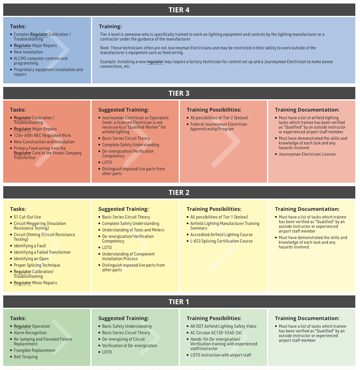
Airfield Lighting Safety and Maintenance Basics
Importance of AN “Electrically Safe Work Condition”
One of the most important decisions an airport manager can make regarding their electrical safety program is whether any electrical work will be allowed beyond an “Electrically Safe Work Condition.”
General Hazards & Risks
The hazards associated with the airport lighting system, while unique, remain the same as other electrical hazards when discussing how they could injure and kill.
Electrical hazards include:
- Electric shock – the primary hazard
- Arc flash and arc blast – typically most hazardous when working on the 208v–480v line voltage side of the constant current regulator or on any other non-series circuit, such as motor control centers, switchgear, and electrical distribution panels
- Fire
Watch the first seven minutes of this video to learn about the hazards of airfield lighting.
Task Decision Matrix
The Task Decision Matrix illustrates the levels of necessary training and work experience necessary for tasks with different levels of complexity.
Maintenance
To ensure safe operation of airfield electrical systems, appropriate maintenance as described in FAA Advisory Circulars and manufacturer equipment documentation is necessary. Managers and those working with airfield electrical systems should be aware of maintenance tasks, risks associated with each task, and electrically safe conditions when performing maintenance tasks.
Tasks which might be common preventative or remedial maintenance activities regarding airfield electrical systems may include:
- Faults
- Opens
- Transformer Failure
- Regulator Failure
Each issue may present unique challenges and hazards, so it is imperative to maintain an electrically safe work condition appropriate to the individual task.
Considerations for senior-level management making policy and budget decisions:
- Is the employee aware of the hazards?
- Is the employee properly trained?
- Does the employee wear proper personal protective equipment (PPE) and understand the appropriate PPE based on each task?
- How many hours of experience does the employee have?
- How was the risk mitigated?
- Document all employee training and exposure.
If an accident or injury occurs, these questions will likely be asked, so it is important to document the scene, PPE used, and all circumstances.
